|
Short Communication
Survey and conservation of a relict population of spider monkeys (Ateles geoffroyi ) in the Sumidero Canyon, Mexico.
David Muñóz1, Alejandro Estrada2 and Yasminda García del Valle1
1Escuela de Biología, Universidad de Ciencias y Artes de Chipas
2Estacion de Biología Tropical Los Tuxtlas, Instituto de Biología, Universidad Nacional Autónoma de México
Corresponding author email: [email protected]
Abstract
Habitat loss, hunting and the pet trade have caused significant reductions in the original distribution of spider monkeys (Ateles spp.) in the Neotropics. Mexico harbors the northernmost distribution of this primate in the Neotropics, and information on the current location of remnant populations and on their demographic features in particularly scarce. In this paper we report the results of a month-long survey during the dry season of a population of spider monkeys (Ateles geoffroyi vellerosus) existing in the rainforest vegetation of the Sumidero Canyon National Park in central Chiapas, Mexico. The 23km-long canyon was divided into five 5km-long segments and the rainforest vegetation at the edges of the river canyon was surveyed from a boat and on the ground for presence of spider monkeys. Surveys resulted in the detection of nine subgroups of spider monkeys in four of the 5km-long segments, for an estimated total population of 36 individuals. Average subgroup size ranged from 3-7 individuals, 28% of these were adult males, 36% were adult females, 28% were juveniles and 8% were infants. Relative abundance was estimated at 1.8 monkeys/km of river. The rainforest vegetation along the river canyon has a patchy distribution and patches are separated by the steep and very tall walls of the canyon. Spider monkeys were observed to move from patch to patch by climbing the walls of the canyon. This unusual behavior allows individual spider monkeys to secure food resources and to meet other conspecifics. Additional surveys are necessary to map annual fluctuations in the size and distribution of the spider monkey population in the canyon.
Key words: spider monkeys, Ateles, Mexico, Sumidero Canyon National Park, primate conservation, Chiapas
Resumen
La pérdida del hábitat, la cacería y el tráfico ilegal de individuos jóvenes como mascotas ha causado reducciones significativas en la distribución original de monos araña (Ateles spp.) en el Neotrópico. México resguarda la distribución mas septentrional de este primate en el continente Americano, pero información acerca de la ubicación actual de las poblaciones remanentes y de sus rasgos demográficos es particularmente pobre. En este trabajo reportamos los resultados de un reconocimiento de la población de monos araña (Ateles geoffroyi vellerosus) existentes en el Parque Nacional Cañón del Sumidero en Chiapas, México. Los 23km de longitud que tiene el cañón fueron divididos en cinco segmentos de 5km de longitud cada uno y la vegetación selvática a la orilla del río fue revisada, desde una embarcación y a pie, para presencia de monos araña. Los reconocimientos indicaron la presencia de nueve subgrupos de monos araña distribuidos en cuatro de los cinco segmentos. Estimamos la presencia de 36 monos araña. De estos, el 28% fueron machos adultos, el 36% fueron hembras adultas, el 28% fueron juveniles y el 8% fueron infantes. La vegetación selvática en la orilla del río del cañón presenta una distribución muy parchada y los parches estas separados por cientos de metros de paredes rocosas que conforman el cañón. Los monos araña fueron observados trasladándose sobre las paredes del cañón para moverse de un parche de vegetación a otro. Este comportamiento les permite encontrar recursos alimenticios y congéneres a lo largo del cañón. Se recomiendan reconocimientos adicionales para perfilar las fluctuaciones en el tamaño y distribución de la población en el cañón.
Palabras clave: monos araña, Ateles, México, Cañón del Sumidero, conservación de primates, Chiapas
|
Received: 15 April, 2008, Accepted 28 May, 2008, Published: 9 June, 2008
Copyright: © 2008 Muñóz, D., Estrada, A., García del Valle, Y. This is an open access paper. We use the Creative Commons Attribution 3.0 license http://creativecommons.org/licenses/by/3.0/us/ .The license permits any user to download, print out, extract, archive, and distribute the article, so long as appropriate credit is given to the authors and source of the work. The license ensures that the published article will be as widely available as possible and that your article can be included in any scientific archive. Open Access authors retain the copyrights of their papers. Open access is a property of individual works, not necessarily journals or publishers.
Cite this paper as: Muñóz, D., Estrada, A., and García del Valle, Y. 2008. Survey and conservation of a relict population of spider monkeys (Ateles geoffroyi) in the Sumidero Canyon, Mexico. Tropical Conservation Science Vol.1 (2):151-162. Available online: tropicalconservationscience.org
Introduction
Mexico harbors the northernmost distribution of non-human primates in the American continent. These are represented by two howler monkey species (the mantled howler monkey, Alouatta palliata mexicana, and the black howler monkey, A. pigra, and one spider monkey, represented by two subspecies Ateles geoffroyi vellerosus (the Mexican spider monkey) and A. g. yucatanensis (the Yucatan spider monkey) [1]. Historically, the Mexican mantled howler monkey had a broad geographic distribution in Mexico, ranging from Los Tuxtlas by the Gulf of Mexico in southern Veracruz to southern Chiapas and into Guatemala and the rest of Central America. In contrast, the Mexican black howler monkey is restricted to the southeast portion of the state of Tabasco, northern Chiapas, and the Yucatan peninsula. It is also present in Belize and in northern Guatemala [2]. In the case of spider monkeys, A.g. vellerosus historically had a broad geographic distribution in Mexico, ranging from southern Tamaulipas and through Central America. The other subspecies, A.g. yucatanensis, is restricted to the Yucatan peninsula [1-2].
Because of their preferences for ripe fruits that are patchily distributed, and the large home ranges required for obtaining these patchy resources, spider monkeys are considered particularly vulnerable to destruction and fragmentation of their natural habitat by human activity [3-4]. In addition, because spider monkeys are among the most frequently hunted monkeys for their meat and for the pet trade, spider monkeys are among the most endangered primates in the Neotropics. [5-7]. Furthermore, the spider monkey's long interbirth interval further impedes rapid population recovery in areas of high hunting pressure, habitat loss, and habitat fragmentation. These factors increase extinction risk [4], and not surprisingly spider monkeys have become locally extinct in many localities in southern Mexico [2,7].
Because human activity continues to alter the distribution of spider monkey populations in the Neotropics [8], data on localities and demographic features of existing spider monkey populations are essential to document areas where populations of spider monkeys are preserved and areas they may be at risk. In the case of Mexico, such information is particularly scarce, but recent survey work has added data for a few localities: Muchukux forest and the Punta Laguna reserve in the Yucatan peninsula [9]; the Calakmul biosphere reserve [10] and the El Tormento forestry reserve [11], both in the state of Campeche and the Yachilán natural monument [10] and the Rio Lacantún region in the state of Chiapas [12].
The state of Chiapas in southern Mexico harbors some of the largest extensions of tropical rainforests in the country and it stands out for its high biodiversity. In the state there are about 41 natural protected areas, among national parks, biosphere reserves, community reserves, and others [16], and they all are administered by the National Commission for Natural Protected Areas (CONANP) [17]. Spider monkeys are historically reported to occur throughout the state, but specific information about the presence and demographic features of populations both outside and inside protected areas is scarce. To our knowledge only three published reports exist on surveys of spider monkey populations for the state of Chiapas. One was carried out in the western portion of the Sierra Madre de Chiapas [18] and others were carried out more recently in the Yachilán natural monument [10], in the Montes Azules biosphere reserve, and in human modified landscapes by Rio Lacantún [12]).
The study and monitoring of spider monkey populations in national parks and biosphere reserves is fundamental for providing baseline and long-term information on variability of demographic traits. Such information is essential also for improving our understanding of species tolerance to anthropogenic disturbance and to assess whether these protected forests are a functioning network and an effective conservation tool [15]. One of the natural protected areas found in central Chiapas is the Sumidero Canyon National Park. Although it has been known that spider monkeys were present there, until now no information was available on demographic features of the population existing in the park. In this paper we report the results of a survey of the population of spider monkeys inhabiting the semi-evergreen and evergreen rainforest of the Sumidero Canyon National Park
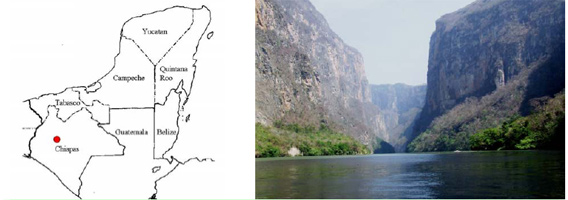
Fig. 1. Left: Approximate location of the Sumidero Canyon National Park in central Chiapas, Mexico. Right: View of of the Sumidero Canyon from a boat. Note the patches of semievergreen and evergreen rainforest at the edge of the river, the low deciduous forest above it, and the steep walls of the canyon. Photo by A. Estrada.
Methods
Study area
The Sumidero Canyon (Spanish: Cañón del Sumidero) is a canyon, carved by the Grijalva River, located at 16° 44' to 16° 57' 10" N; 93° 00' 12" and 93° 10' 54" W, and about 40 km from Tuxtla Gutiérrez, capital of the Mexican state of Chiapas (Fig. 1). The length of the canyon is about 23km and its cliffs overlook the Grijalva River, which extends across the states of Chiapas and Tabasco and flows into the Gulf of Mexico. In its southern entrance, the canyon begins near the city of Chiapa de Corzo, and flows into the reservoir of the hydroelectric dam Chicoasén. The dam was built in the 1970s and it became operational in 1980, when the river depth increased substantially [19]. This canyon is a result of a geological fault and it is assumed to be about 130 million years old, contemporary with the Grand Canyon in the USA [19]. The extremely vertical walls of the canyon range in height from 700 to 1200 m. Separation between the walls of the canyon ranges from 0.8 to 1 km. The canyon is regarded as an important tourist attraction in the state of Chiapas and thousands of people visit the area every year [19].
The Sumidero Canyon National Park was established in 1980 and covers about 21,789 ha. The canyon harbors three main types of vegetation:
· Low deciduous forests, about 4-10 m tall; 80% or more of the plants lose their leaves for up to six months of the year. This is the most common vegetation type and it is found in the upper parts of the canyon and on the plateau behind the canyon's walls.
· Semievergreen rainforest, approximately 15-30 m tall; about 40% of the plants lose their leaves during the dry season.
· Evergreen rainforest, approximately 15-30 m tall.
The latter two types of forest vegetation are found in the form of isolated patches along the river and at the bottom of a few ravines flowing from the upper parts of the canyon into the river [19]. Average annual precipitation is 957 mm with a rainy season between May and October. Mean annual temperature is 28.2o C (range 12.6 — 42.3oC). About 60 species of mammals have been identified in the canyon and about 16 species of birds, six mammals, and a butterfly are endemic [19]. Some of the most evident species are the Great Curassow (Crax rubra), spider monkeys (Ateles geoffroyi), crocodiles (Crocodylus acutus), yaguarundi (Felis yagouaroundi), ocelot (Leopardus pardalis), white-tailed deer (Odocoileus virginianus), brocket deer (Mazama americana), and tamandua (Tamandua tetradactyla), among others.
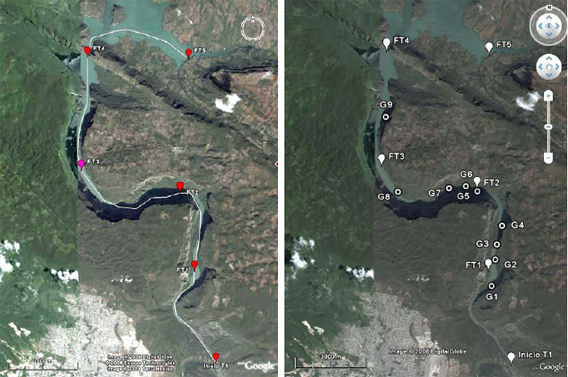
Fig. 2 (left). Approximate location and shape of the five 5km-long sectors (white line) into which the river canyon was divided to survey the spider monkeys from a boat. T1, sector 1; FT1, end of sector 1; FT2, end of sector 2; FT3, end of sector 3; FT4, end of sector 4; FT5, end of sector 5. Image modified after Google Earth. Fig. 3 (right). Locations where spider monkey subgroups were detected along the river canyon. White circles with the "G" and a number indicate the identity of the subgroup. Image modified after Google Earth.
Surveys of spider monkeys
Surveys were carried out between December 10, 2007, and January 25, 2008, during the dry season, to maximize visibility. These were conducted by slowly navigating the Grijalva River on a boat. The course of the river was divided into five 5km-long sectors, starting at the Sabinal River at the south end of the canyon and ending in the area of the Chicoasén dam at the northern extremity of the canyon (Fig. 2 and 3).
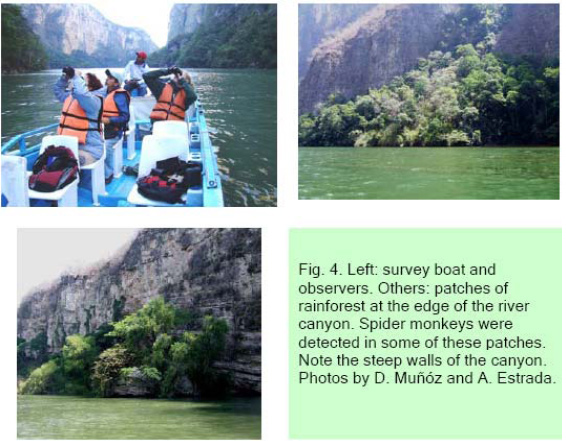
Both the east and west sides of the river in each sector were surveyed three times from 7:00-13:00 hrs on three consecutive days. Surveys were carried out up river and down river as well. The speed of the boat was kept constant (2km/h) and 2-3 people scanned each side of the river with the aid of binoculars for the presence of monkeys. When spider monkeys were sighted, we stopped the boat and proceeded to get a detailed count of individuals by approaching the river's edge or by positioning the boat in the best position to view the monkeys (Fig. 4). In the majority of cases, we also went on land to further improve the accuracy of the counts. Once a consensus was reached on the observations as to the number of monkeys present and on their sex and general age (adults, juveniles, and infants clinging to their mothers), we continued the survey along the same 5 km sector. Once the 5km marker was reached, we repeated the process, returning to point zero on the same 5km sector. Location of sightings of spider monkeys as well as distances traveled by boat along each sector were recorded and monitored, respectively, with a GPS. These records were later transferred to a map to scale.
To accurately differentiate sightings of spider monkey subgroups and avoid counting the same subgroup two or more times, we took careful records of the age and sex composition of the subgroup, the location of the forest patch, the time and date of the sighting, and the distance from other spots along the river sector where other sightings of spider monkeys had been made.
Spider monkeys live in small temporary subgroups of unstable composition, which are part of larger groups or communities [3,20,21]. Because of the fusion—fission nature of their social organization, it is rare to see all members of the community in the same location, suggesting that it is not easy to make generalizations on density and/or subgroup size for this primate species [3]. Bearing this in mind, the population data presented below should be interpreted as general estimates. Relative abundance of spider monkeys was calculated as individuals/km of river.
Results
We completed 30 days and about 195 hrs (585 observer hours) of surveys of the spider monkey population found along the Rio Grijalva in the Sumidero Canyon. Survey effort resulted in detection of spider monkeys in 24 localities in the canyon but these took place in sectors 1 to 4 only (Fig 3). Absence of spider monkeys in sector 5 is probably due to replacement of the original forest vegetation by pasture lands. All detections of spider monkeys in sectors 1 to 4 took place on the east side of the river. No spider monkeys were detected on the west side and consultations with the park guards indicate that they had never seen spider monkeys on that side of the river (Fig. 3; Table 1). All detections of spider monkeys were made in patches of semievergreen or evergreen rainforest along the edge of the river.
Table 1. Subgroups of spider monkeys detected in patches of rainforest on the east side of the river in the Sumidero Canyon National Park. AM adult males, AF adult females, JM juvenile male, JF juvenile female, I clinging infant.
|
Subgrup |
AM |
AF |
JM |
JF |
I |
Total |
Sector |
|
1 |
1 |
1 |
2 |
1 |
0 |
5 |
1 |
|
2 |
0 |
1 |
1 |
0 |
1 |
3 |
2 |
|
3 |
0 |
1 |
0 |
3 |
0 |
4 |
2 |
|
4 |
1 |
2 |
0 |
1 |
0 |
4 |
2 |
|
5 |
1 |
3 |
1 |
0 |
2 |
7 |
3 |
|
6 |
0 |
3 |
0 |
0 |
0 |
3 |
2 |
|
7 |
3 |
0 |
0 |
0 |
0 |
3 |
3 |
|
8 |
1 |
1 |
1 |
0 |
0 |
3 |
3 |
|
9 |
3 |
1 |
0 |
0 |
0 |
4 |
4 |
|
Total
|
10 |
13 |
5 |
5 |
3 |
36 |
|
|
Average
|
1.11 |
1.4 |
0.56 |
0.56 |
0.33 |
4.0 |
|
|
|
|
|
|
|
|
|
|
Our survey resulted in the sightings of 60 spider monkeys, but examination of repeated-count data, consecutive-day sightings, distances separating sightings and inter-observer consensus, indicated the presence of 36 spider monkeys in nine subgroups (Table 1; Fig. 5). These subgroups were not evenly distributed in the sampled 5km-long sectors of the river (Fig.3). One subgroup was detected in sector 1, four subgroups in sector 2, three in sector 3 and 1 in sector 4. Mean distance separating these subgroups from one another was 1443.1 + 1032.8m (range 520-3364 m; Table 2).
Table 2. Distance between sightings of spider monkey subgroups along the east side of the river in the Sumidero Canyon National Park. For example, 1-2 refers to distance between subgroup 1 and 2 (1,101m), and so on.
|
|
Spider monkey subgroups |
|
|
1 - 2 |
2 - 3 |
3 - 4 |
4 - 5 |
5 - 6 |
6 - 7 |
7 - 8 |
8 -9 |
|
|
|
|
|
|
|
|
|
|
|
Distance (m) |
1,101 |
545
|
790
|
2,110
|
520 |
730
|
2,310
|
3,364
|
|
|
|
|
|
|
|
|
|
|
Twenty-eight percent of the 36 spider monkeys counted were adult males, 36% were adult females, 14% were juveniles males, 14% were juvenile females, and 8% were infants. Relative abundance of spider monkeys along the river's east side (sectors 1-4) was estimated at 1.8 monkeys/km (N/20 km).

Fig. 5. Left: subgroup of spider monkeys formed by two adults. Center and right: an adult female and an adult male in one of the rainforest patches by the edge of the river canyon. Photos: D. Muñóz.
Average subgroup size was 4.0 individuals (s.d. 1.32; range 3-7). Average number of adult males and adult females per subgroup was 1.1±1.2 and 1.4±1.0, respectively. Ratio of adult males to adult females was 1:1.3 and 1:1 for juveniles. The ratio of adult females to immatures (juveniles and infants) was 1:1 and that for adults to immatures was 1:0.56. In two of the subgroups only adult females and associated juvenile and infants were detected (Table 1; Fig. 5).
During the surveys we observed the spider monkeys feeding on the fruits, leaves, and flowers of tree species common in the patches of semievergreen and evergreen rainforest. Some of the tree species used were Ficus spp. and Brosimun alicastrum (Moraceae), Bursera simaruba (Burseraceae), Pseudobombax ellipticum (Bombacaeae), among others (Fig. 6).
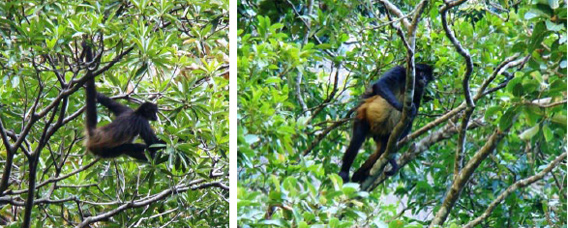
Fig. 6. Two adult spider monkeys feeding on fruits and leaves in one of the rainforest patches by the river canyon. Photos: D. Muñóz.
Discussion
Our brief survey showed the presence of a small population of spider monkeys inhabiting the semievergreen and evergreen rainforest patches present along the edge of the river on the east side of the canyon. Because of the fluid organization (fusion-fission) typical of Ateles and the monkeys' rapid arboreal locomotion, it is possible that we underestimated the actual number of spider monkeys in the canyon. Furthermore, the topographical conditions of the Sumidero Canyon (steep vertical walls) allowed for accurate visual surveys only from the river. The steep terrain decreased our terrestrial mobility, and impeded our ability to track the spider monkeys once they traveled to forest patches that were further from the river and at greater elevation (Fig. 7).
The patchy distribution of the vegetation suitable for the permanent existence of spider monkeys along the sides of the river canyon may be another factor making detection of the monkeys difficult. These patches are separated from one another by hundreds of meters of rock-solid cliffs (Fig. 7). How do the monkeys move from one patch to another? Our observations indicate they do it by climbing up the cliff and moving along it, vertically and horizontally, until they reach another forest patch (Fig. 8). Such ability probably allows the spider monkeys to sustain themselves in the dry season by exploiting food resources in the several parches of rainforest vegetation available along the river edge of the canyon. In addition, such movements may allow individuals and/or subgroups to meet conspecifics, thus sustaining social and reproductive contacts.
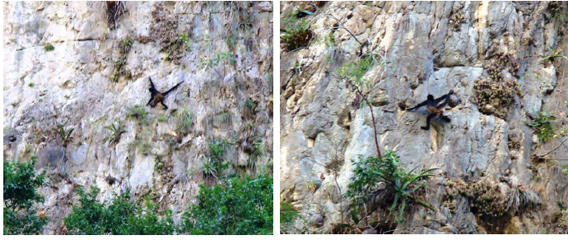
Fig. 8. Spider monkeys moving vertically and horizontally on the wall of the canyon to reach other rainforest patches along the edge of the river canyon. Photos: D. Muñóz.
Implications for conservation
Information on the spider monkey population in the Sumidero Canyon National Park needs to be complemented by additional surveys throughout the year. These should encompass the rainy season when the low deciduous forest is flush with foliage. It is possible that spider monkeys may move to the upper parts of the canyon where this vegetation is found in order to harvest fruit and leaves. Consistent with this, interviews with local inhabitants of three small communities in the plateau above and east of the canyon's eastern ridge indicate that they occasionally see spider monkey in that area, but only in the rainy season.
Spider monkeys are endangered as a result of habitat loss, and hunting and illegal trafficking of infants as pets are still common in southern Mexico [7]. Furthermore, human population growth and density and urban development are greatest in the central portion of the state of Chiapas [19], where much of the original vegetation has been converted for agricultural purposes, for urban expansion or for the construction of large hydroelectric dams. Therefore, the conservation of the Sumidero Canyon's spider monkey population is of special importance.
Several factors may have favored the persistence of the spider monkey population in the Sumidero Canyon area over the past few decades. One is the difficult topography. Before the Chicoasén dam was built, the canyon walls were even higher than they are now and the river was not navigable, conditions that mitigated against access by people to the canyon's interior. When the Chicoasén dam was completed in 1980, the canyon was flooded and the river became navigable, but creation of the national park in the same year probably deterred hunters and poachers [19].The creation of the Sumidero Canyon National Park enhanced and consolidated not only the protection of the forest vegetation along the course of the river, but also that of the land surrounding the canyon (Fig. 9).
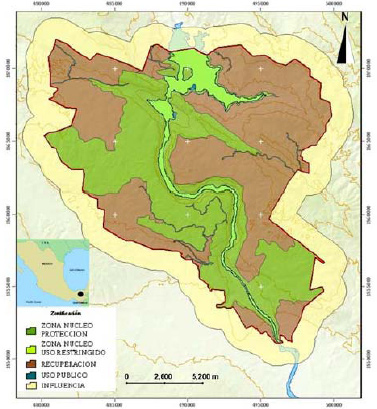
The demographic parameters reported here for the spider monkeys in Sumidero Canyon National Park (e.g., subgroup size, male to female ratios, adult to immature ratios) fall within the range of values reported for other spider monkey populations found in other protected forests in southern México (the Biosphere reserve of Calakmul and Yaxchilán natural monument [10]; the Montes Azules biosphere reserve [12]), and Tikal National Park, Guatemala [10].
The absence of spider monkeys on the west side of the river canyon may be the result of historically greater accessibility of humans to the western side of the national park, before the park was created. Access roads and the building of a major highway linking the state capital with cities to the west and north in the central highlands and neighboring states transformed the landscapes on the western side of the canyon and this may have resulted in greater pressures upon the primate fauna. It is possible that before the Chicoasén hydroelectric project was built spider monkeys occurred on both sides of the Grijalva River. However, after the canyon was flooded, dispersal of spider monkeys from the east to the west side of the river probably became impossible. The expansion of the urban area of the city of Tuxtla Gutierrez, the state capital, at the southwest end of the canyon (see white area in lower left corner of Fig. 2) was probably an added factor, but fortunately the establishment of a buffer zone and core protected areas incorporated into the national park's management plan has somewhat diminished such pressures [19] (Fig. 9).
The Sumidero Canyon is a very important tourist attraction. More than 250,000 tourists visit the park each year [22,19]. While many come to the highest points of the park to view the natural geologic formation, they also visit its interior by boat. The service is provided by an organized guild of boatmen from the city of Chiapa de Corzo, at the beginning of the canyon, who take the tourists along the river where they can view the tall walls of the canyon and also the observable fauna and flora in the patches of semi-evergreen and evergreen rainforest along the river's edge (Fig.10). Tourists can view many birds in these patches as well as the spider monkeys. The charismatic appeal of this primate enhances the intrinsic value of the canyon in the public eye, making the visit more attractive. This raises awareness among the public regarding the importance of preserving the forests and the spider monkeys that exist in the canyon.
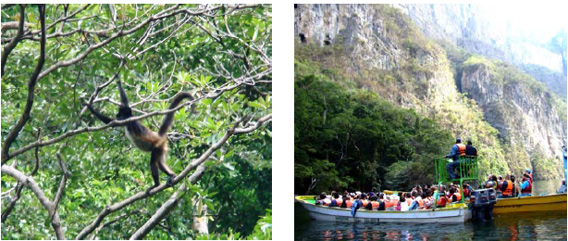
Fig. 10. Spider monkeys of the Sumidero Canyon National Park have adapted in intriguing ways to their environment: they seem to sustain themselves from edible fruits and leaves offered by many plant species in the rainforest patches along the river canyon, breeding success is evidenced by the presence of juveniles and infants in the population, and the tall walls of the canyon seem not to represent an absolute obstacle for individuals spider monkeys to sustain contact with other members of their community. Photos: D. Muñóz.
To conclude, it is evident that more surveys of the spider monkey population of the Sumidero Canyon National Park need to be carried out, and these should encompass one or more annual cycles. This will confirm the estimates regarding the size of the population existing in the canyon and will provide important data on seasonal and inter-annual fluctuations in presence, size, and demographic structure of the population. Similarly, studies are needed to document how the spider monkeys sustain themselves throughout the year, both when they inhabit the semi-evergreen and evergreen rainforest by the edge of the river and when they move into the deciduous forest at higher elevations during the rainy season. Coupled to these efforts, educational programs aimed at improving the boatmen's knowledge about the natural history of the spider monkeys in the canyon will benefit both the service they provide for tourists and will raise conservation awareness. The conservation of a relict population of an endangered primate such as the spider monkey in the Sumidero Canyon National Park is a good example of the interplay between national and local policies in Mexico for protection of unique natural areas and the linking of this with economic alternatives (e.g., ecotourism), rather than habitat destruction and hunting, thus benefiting local inhabitants [4].
Acknowledgements
We acknowledge the support provided by CONANP (Comisión de Areas Naturales Protegidas) of the Mexican government environmental agency, Chiapas, who requested that this survey be carried out. We are grateful to Luis Alberto Pineda Alcazar and Felix González Cruz, students from the University of Sciences and Arts of the state of Chiapas and to Katherine Amato, Dartmouth College, for assistance in conducting the surveys. We thank three anonymous reviewers for helpful comments and advice in improving earlier drafts of this manuscript.
References
[1] Rylands, A. B., Groves, C. P., Mittermeier, R. A., Cortes-Ortiz, L. and Hines, J. H. 2006. Taxonomy and distributions of Mesoamerican primates. In: New Perspectives in the Study of Mesoamerican Primates. Estrada, A., Garber, P. A., Pavelka, M. and Luecke, L. (eds.), pp. 29-79. Springer Press, New York.
[2] Estrada, A. and Coates-Estrada, R. 1988. Tropical Rain Forest Conversion and Perspectives in the Conservation of Wild Primates (Alouatta and Ateles) In México. American Journal of Primatology 14:315-327.
[3] Di Fiori, A. D. and Campbell, C. J. 2007. The Atelines: variation in ecology, behavior and social organization. In: Primates in Perspective. Campbell, C. J., Fuentes, A., MacKinnon, K. C., Spencer, M. and Bearder, S. K. (Eds.), pp. 155-185. Oxford University Press, New York.
[4] Strier, K. B. 2007. Conservation. In: Primates in Perspective. Campbell, C. J., Fuentes, A., MacKinnon, K. C., Spencer, M. and Bearder, S. K. (Eds.), pp. 496-509. Oxford University Press, New York.
[5] Kinzey, W. G. 1997. Ateles. In: New World Primates: Ecology, Evolution and Behavior. Kinzey, W. G., (Ed.), pp. 192-199. Aldine de Gruyter, New York.
[6] Rylands, A. B., Mittermeir, R. A. and Rodriguez-Luna, E. 1997. Conservation of neotropical primates: threatened species and an analysis of primate diversity by country and by region. Folia Primatologica. 8:134-160.
[7]Duarte, A. and Estrada, A. 2003. Primates as pets in Mexico City: an assessment of species involved, source of origin and general aspects of treatment. American Journal of Primatology 61: 53-60.
[8] Estrada, A., Garber, P. A., Pavelka, M., and Luecke, L. G. 2006. Overview of the Mesoamerican primate fauna, primate studies and conservation concerns: An introduction. In: New perspectives in the study of Mesoamerican primates: Distribution, Ecology, Behavior and Conservation. Estrada, A., Garber, P. A., Pavelka, M. S. M. and Luecke, L. (Eds.), pp. 1—22. Springer Press, New York.
[9] Ramos-Fernández, G. and Ayala-Orozco, B. 2003.Population size and habitat use of spider monkeys in Punta Laguna, Mexico. In: Primates in Fragments: Ecology and Conservation. Marsh, L. K. (Ed.), pp. 191-209. Kluwer Academic Plenum Publishers. New York.
[10] Estrada, A., Luecke, L., Van Belle, S., Barrueta, E. and Rosales-Meda, M. 2004. Survey of black howler (Alouatta pigra) and spider (Ateles geoffroyi) monkeys in the Mayan sites of Calakmul and Yaxchilán, Mexico and Tikal, Guatemala. Primates 45:33-39.
[11] Barrueta, T., Estrada A., Pozo, C. and Calmé, S. 2003. Reconocimiento Demográfico de Alouatta pigra y Ateles geoffroyi en la Reserva El Tormento, Campeche, México. Neotropical Primates 11:165-169.
[12] Estrada, A., Van Belle S., and García del Valle Y. 2004b. Survey of black howler (Alouatta pigra) and spider (Ateles geoffroyi) monkeys along the Río Lacantún, Chiapas, Mexico. Neotropical Primates 12:70-75.
[13] Estrada, A. In Press. Primate conservation in South America: the human and ecological dimensions of the problem. In: South American Primates: Comparative Perspectives in the Study of Behavior, Ecology, and Conservation. Garber, P. A., Estrada, A., Bicca-Marques, J., Heymann, E. and Strier, K. B. Springer Press, NewYork.
[14] Laurance, W. F. and Peres, C. A. Eds. 2006. Emerging Threats to Tropical Forests. Chicago: University of Chicago Press.
[15] Rodrigues, A. S. L., Andelman, S. J., Bakarr, M. I., Boitani, L., Brooks, T. M., Cowling R. M., Fishpool, L. D. C., da Fonseca, G. A. B., Gaston, K. J., Hoffmann, M., Long J. S., Marquet, P. A., Pilgrim, J. D., Pressey, R. L., Schipper, J., Sechrest, W., Stuart, S. N., Underhill, L. G., Waller, R. W., Watts, M. E. J. and Yan, X. 2004. Effectiveness of the global protected area network in representing species diversity. Nature 428:640-643.
[16] PRONATURA-CHIAPAS. 2007. [http://www.pronatura-chiapas.org/
[17] CONANP. 2007. http://www.conanp.gob.mx/
[18] Hernández-Yanez, A. 1993. Situación del mono araña mexicano (Ateles geoffroyi vellerosus) en la porción oeste de la Sierra Madre de Chiapas. Revista de Difusión Científica 5: 23-30.
[19] CONANP. 2007. Programa de Conservación y Manejo, Parque Nacional Cañón del Sumidero. Comisión Nacional de Áreas Naturales Protegidas, México.
[20] Van Roosmalen, M.G.M. and Klein, L.L. 1988. The spider monkeys, genus Ateles. In: Ecology and Behavior of Neotropical Primates, Vol. 2, Mittermeier, R. A., Rylands, A. B., Coimbra-Filho, A. F. and da Fonseca, G. A. B. (Eds.), pp.455—537. World Wildlife Fund, Washington, DC.
[21] Kinzey, W. G. 1997. Ateles. In: New World Primates: Ecology, Evolution and Behavior. W. G. Kinzey (ed.), pp.192—199. Aldine de Gruyter, New York.
[22] World Bank and Fondo Chiapas. 2000. Fondo Chiapas (FCH), International Finance Corporation (IFC), and Consultoría y Administración de Proyectos (CAP) http://www.ifc.org/
|










